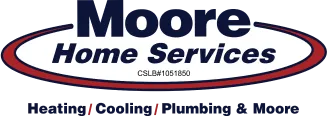How Does a Furnace Work? Furnace Parts and What They Do
Posted by Moore Home Services
News
A furnace is something every Santa Rosa homeowner needs. While our winters are mostly mild, they can still get very cold. While the furnace is a necessity, we’ve come to realize a lot of people don’t actually know how they work. If you’re wondering how does a furnace work? We’ve put together this list of furnace parts and what they do.
The Parts of Your Home Furnace
Return Register
You know those vents that are at the top and bottom of your walls? Those are the return and supply registers. When air cycles through your HVAC system, the return register is the first part of the process. When your system turns on, it pulls ambient air from the inside of your home.
Return Duct
That air the return register just sucked up, it needs to go somewhere. That’s why the return duct exists. It makes sure the air that was pulled in by the return register is directed to your HVAC system.
Air Filter
At Moore Home Services, we believe the HVAC air filter is one of the most important parts of your system. It has two critical jobs. First, it stops too much dust from getting into your furnace. This helps maintain the life of your furnace. Next, it keeps indoor air contaminates from being cycled throughout your house.As air is pulled from the return duct into the furnace, it passes through the filter. During this pass through, the air filter catches airborne particles, which include dust, dander, allergens.
Blower
True to its name, the blower is responsible for pulling air from the return register and sending that air through the rest of the HVAC system. With the help of the blower motor, this fan pushes air through the steps listed below. Without the blower, air would have not had the power it needs to go through the heat treatment process.
Blower Motor
While the blower itself is a big fan, it’s powered by the blower motor. The motor keeps the fan spinning.
Blower Chamber
Without the blower chamber, the blower and blower motor would have no stability. The blower chamber is essentially a box that holds everything in place.
Burners
Without burners there would be no fire. The burners themselves pull and distribute natural gas into the combustion chamber. A little spark from the pilot light or electronic ignition sets the burners ablaze and this is where we start the heating process.
Flame Sensor
The flam sensor is so small, most homeowners would never notice it. Though it’s small, the flame sensor plays an important role in HVAC safety. The flame sensor regulates the heat coming off the burners. The flame sensor does nothing until something goes wrong. It’ll only turn off your system or alert you when there isn’t enough heat coming out of the burners. This is important because if the burners are emitting gas, but there’s no flame, harmful gasses are in your home. The same type of gasses that lead to carbon monoxide poisoning. The flame sensor will shut your system down to prevent the distribution of noxious gasses in your home.
Pilot Light or Electronic Ignition
All furnaces either have a pilot light or an electronic ignition. It all depends on the age of your system. Systems that are a decade or older will have a pilot light, newer ones are equipped with an electronic ignition.These two parts essentially do the same thing—spark a flame—they go about it in different ways. Pilot lights are always burning. Meaning they’re always ready for action. When you turn on your system, the pilot light is already on and ready to make warm air. The downside to this is that you’re wasting money on gas—because it’s always running, and they could pose a safety hazard.Modern furnaces have an electronic ignition instead of a pilot light. The electronic ignition sparks a flame, just like the pilot light, but it isn’t always on. An electronic ignition turns on when it receives a signal from the thermostat. It’s a safer way of starting fire.
Burner Cover
For your safety, all this fire and gas is contained by a burner cover. The burner cover is a metal lid that sits atop the burners, flame sensor, and pilot light or electronic ignition and makes sure everything stays in one place.
Combustion Chamber
Just like the blower chamber, all the flame pieces, cover included, are housed in the combustion chamber. For safety reasons, this part is separate from the blower chamber and makes sure fire and gasses are housed in one place.
Heat Exchanger
The heat exchanger is the place where your air gets nice and toasty. This device pulls all “combustion gasses” from the combustion chamber. While these combustion gasses are incredibly toxic to human health, they are the secret sauce that heat your air.The combustion gasses warm the outside walls of the heat exchanger. While this is happening, treated air from the air filter flows over the heat exchanger. While the filtered air is running over the heat exchanger, the warm outside walls transfer their heat to the air.After the filtered, and now warm, air is distributed to your home, the heat exchanger pushes the combustion gasses out a flu pipe and out of your home.
Supply Plenum
After all this, your air is finally nice and warm and is ready for your home. With the help of the blower, it travels through the supply plenum. The supply plenum pushes the air into the damper.
Damper
The damper acts as a traffic director. While the supply plenum is a holding chamber for warm, treated air, the damper is what distributes it. Based on your zoning and thermostat settings, the damper will send air through different supply ducts until your home is comfortably warm.
Supply Duct
Once the air leaves the damper, it needs to be directed. The supply duct directs air to the supply registers where it will then be distributed into your home.
Supply Register
The heating process ends at the supply register. These vents push air out and basically supply your home with treated air.
It’s Never Too Early for Too Late for a Tune-Up
One of our favorite things about HVAC systems is that they’re generally low maintenance. The best way to care for your system is to schedule twice yearly tune-ups. One in the spring before the start of AC season, and one in the fall before furnace season. The HVAC experts at Moore Home Services make sure to look at every part of your system and advise you of any potential safety issues.
Moore Home Services Provides the Best Service in Santa Rosa
We provide the best HVAC tune-ups in Santa Rosa, Sonoma County, and the North Bay. Moore Home Services is a Diamond Certified company, and we have the reviews to back it up. To schedule your own stellar service, call the number at the top of the screen or click here to book an appointment online.


